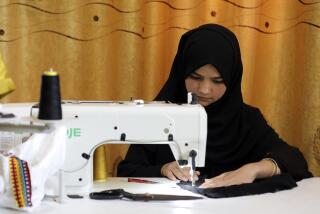Dalit women find their voice through a newspaper
BANDA, INDIA — The pen, it’s sometimes said, is mightier than the sword. For these women, it’s also a ticket to respect.
Khabar Lahariya, or “News Waves,” is India’s first newspaper written, read and run by tribal women and those from the Dalit, or so-called untouchable, caste.
While most readers know only of the politics, crime or education news in the 8-page weekly, each of the writers has a story of her own about struggling against life’s harsh challenges.
Many of the dozen or so women on staff were beaten or sexually abused as children, married off young, endured abusive marriages and fought mightily for an education and a divorce. Often, the newspaper provides them with a voice on important issues for the first time in their lives along with a sense of confidence and purpose.
The paper is also a labor of love. Not only do the women write the stories, which appear in a local minority language, Bundeli, they edit, handle layout, proofread and solicit ads for its two editions. And staff members, paid between $60 and $140 a month, spend several days each week lugging copies to distant villages, some accessible only by hiking trails, to flog what they’ve produced.
“We take buses, cars, motorcycles until the road stops, then we walk,” said Meera, 23, who like many here uses only one name, while sitting beside a whiteboard with the week’s stories mapped out. “It’s hard enough to reach many of these remote areas. Then you have to stay and sell the papers.”
In the remote communities, they pick up stories from readers or from residents petitioning for justice in courts and government offices. Thus armed, they return to their weekly editorial meeting with a minimum of five ideas and hash out among themselves what stories will make it into print.
The paper’s recent stories included alleged bribery at health clinics, a bureaucrat reported to be siphoning off money meant for widows and a piece on the brother of a powerful politician who built a house, blocking water that had gone to Dalit farmers nearby and destroying their livelihood.
A few years ago, the paper did a story on a groom who had refused to marry his fiancee because her family wouldn’t give him an appliance he wanted. Their story -- under the headline “Do you want a wife or a TV?” -- got huge attention. Today the couple are happily married and joke about the incident.
The 4-cent cover price for Khabar Lahariya may seem like a pittance. But here in rural Uttar Pradesh state, where poverty is widespread and Internet use is not, this often represents a huge sum.
Sometimes the staff members barter copies of the newspaper for food or firewood. They might even give away free copies if someone is impoverished but seems particularly interested.
Staff members estimate that each of the 4,000 weekly copies is read by, or to, at least 10 other people, a function of the area’s limited literacy and extreme poverty.
The newsstand price covers less than 20% of the operation’s $67,000 annual operating budget. The difference is covered by Nirantar, a New Delhi-based civic group specializing in gender, literacy and development issues. The group conceived of the project and believes it can serve as a model for other communities in India. A few weeks ago, the project won a UNESCO literacy prize.
Khabar Lahariya focuses its articles on issues of importance to Dalit, tribal or other underprivileged communities not covered elsewhere. When Dalits are featured in the mainstream press, reporters said, the approach is often sensational and superficial.
At the core, the women seek to help their mostly downtrodden readers know their rights, understand what government programs are available and teach them how to apply for assistance.
Meera, 38, who has the same name as her fellow editor, said the staff faced huge resistance when the newspaper launched in 2002. Feudal kingpins long used to subjugating their workers; landlords who didn’t want their exploitative practices revealed; corrupt officials; even journalists, who are often part of the old boys’ club -- all resented their appearance on the scene.
The younger Meera said she had argued extensively with her father and husband before they let her earn a master’s degree in political science and take the newspaper job.
The women say the newsroom structure remains loose and titles are often trumped by a system of respect among equals. A key point in many of the women’s lives came when they realized, usually at some point in primary or middle school, that as Dalits they’d been born at the bottom of India’s social pyramid.
For the younger Meera, the painful awareness came when she realized the teacher in her remote village never drank the water she offered him and would accept it only from higher-caste students.
Reporter Mithlesh, 44, remembers noticing that her primary school teacher segregated the “sweeper,” or lower-caste, children from the rest, encouraging the higher-caste kids to wash their clothes if a sweeper’s child touched them.
Shanti, another staffer, said her family was so poor and of such a low status that she never attended school. At 32, she divorced an alcoholic husband who regularly beat her, taking their five children and starting her education from scratch. Now 40, she’s supporting the family with her newspaper job and ensuring her children are educated.
“Now I can read and people don’t cheat me anymore,” she said.
Caste is a social institution and it’s probably here to stay, the women said. But if you’re educated and know your rights, people are more respectful. As Indian society changes, affected by urbanization and internal migration, a more liberalized economy and political shifts, the grip of this restrictive system is slowly weakening.
Dalit women say they can be their own worst enemies given that caste distinctions are ingrained from birth. Then there’s the prevalent belief that individuals somehow deserve their fate because of good or bad karma carrying over from the last life.
“I don’t think I did anything wrong in my last life,” the younger Meera said. “I’m a human.”
Disha Mullick, a Nirantar program coordinator based in New Delhi who helps train prospective reporters, said the social pressure to “stay in your place” extends to those holding staff jobs. In spite of the opportunities that come with working at the newspaper, there is a huge turnover. Many women leave after a few weeks or months, uncomfortable with taking a more assertive role.
But for many of them, the very act of doing a job at which they ask challenging questions of high officials, rich locals and derisive politicians is empowering, the women said. Learning how to use technology is also pretty nifty, some said.
“This job has really helped me stand up and be independent,” said Kavita, 30, another co-editor. “A year ago, I never even imagined something like a computer or the Internet existed. This Google is amazing. You can read other newspapers just like that.”
Readers have responded and circulation is growing, up from 2,500 a few years ago.
“Other papers aren’t printed in our language and don’t write about local news we’re most interested in,” said Balbir Singh, 36, owner of a small shop in Jauharpur. “This really feels like our own. I just wish it were more than eight pages so I’d have more to read.”
--
Anshul Rana in The Times’ New Delhi Bureau contributed to this report.
More to Read
Sign up for Essential California
The most important California stories and recommendations in your inbox every morning.
You may occasionally receive promotional content from the Los Angeles Times.










